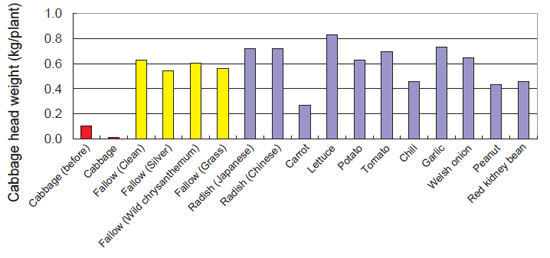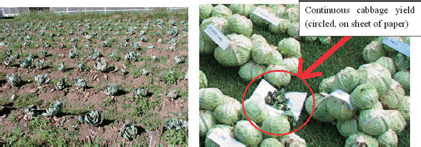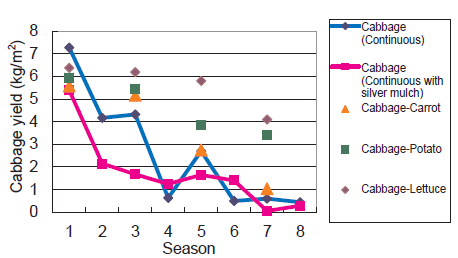Evaluation of the ability of vegetable crops to reduce clubroot damage using preceding crops in the West Java Highlands
Description
Indonesia is typical of tropical island countries where it is difficult to cultivate temperate vegetables such as cabbage, Chinese cabbage, and cauliflower. These crops will grow only in highland areas, where they are cultivated throughout the year. Highland farmers favor cultivation of temperate vegetables due to their relatively good production levels compared to the lowlands and their high prices. This leads farmers to adopt continuous or very frequent cropping of Cruciferae, resulting in a high incidence of clubroot damage. There is an urgent need to develop environmentally friendly technologies that are able to reduce clubroot damage using less chemical input and having minimal environmental impact, that are suitable for areas which are often steeply sloping but with good water resources.Short-term crop rotation systems have been shown to be an environmentally friendly and effective technique for minimizing damage to cabbage production caused by clubroot infection. In order to enhance the efficacy of this technique and improve its convenience of use to farmers, the effects of planting several other vegetables and plants on the ability to reduce clubroot damage was evaluated. In an 8-month experiment, eleven vegetable plots and four fallow plots were set up in a severely infested field in what were previously continuous cabbage cropping plots. Two of the fallow plots were seeded with common local weeds: grasses (Zoysia sp.) and wild chrysanthemum, Galinsoga parviflora. The other fallow plots were simply kept clean by hand weeding or with silver mulching film. Long-term crops such as chili, peanut, and tomato were grown as a single crop for 8 months, and other short-term crops were grown two or more times to ensure continuous cultivation. For vegetables such as cabbages, carrots, and potatoes, 8 months corresponds to two growing seasons. After using the plots to grow the abovementioned vegetables, cabbage plants were grown again in all of the plots and their productivities evaluated. Cabbage yields in plots planted after 8 months’ cultivation of different kinds of vegetables are shown in Fig. 1. The yield before planting such vegetables was 0.11 and that of the continuous cropping plots was only 0.02 kg/plant mass. These yields are very low and the crops were practically worthless due to there being very few heads of marketable quality. In the formerly fallow plots, yield recovered to 0.6 kg/plant mass, showing that fallow treatment can markedly reduce clubroot damage. As shown in Fig. 2, there were both good quality individual plants and poor quality plants in the same plots. As a result, average head weight was rather low, but marketable heads were still produced. There were only minor differences between all the fallow conditions, suggesting that weed growth does not decrease the recovery effects, although it did reduce soil temperature. Silver mulching film, although it raised soil temperature, similarly did not enhance this effect.
The planting of lettuce showed the highest beneficial effects, followed by garlic,radishes, and tomatoes. Radish is known to be a clubroot decoy crop. This plant triggers the germination of clubroot spores but is resistant to them. As for lettuce, no information is available concerning the mechanisms of its anti-clubroot effects. Yields obtained by planting spring onions and potatoes were almost the same as those of the fallow treatment, suggesting that these vegetables have no special anti-clubroot effects.
Chili, kidney beans, peanuts, and carrots showed less efficacy than did the fallow treatment. Chili and peanuts are long-term plants, and shade the soil with their canopy for a longer time than other plants, with carrots providing the thickest cover.
Important crops were also evaluated in very short-term crop rotations with cabbage.For this purpose, evaluation of these vegetables in very short-term crop rotations (alternate cultivation) was conducted in plots where clubroot damage was very low. The results compared with continuously cropped cabbage plots are shown in Fig. 3. In the rotation plots, cabbage yields also decreased, but more slowly than those of the continuous cropping plots. The order of loss of yield was in agreement with the results of the former experiments, in that planting after lettuce showed the lowest clubroot prevalence, followed by potatoes. Combination planting with carrots showed the fastest decrease in yield. Although the period of use of plants for suppressing clubroot damage was only 4 months, damage-recovery effects could still be detected and the order of efficacy was the same in these two experiments. Although the planting of certain vegetables was less effective than the fallow conditions, they were still partially effective. Highland farmers have numerous vegetables to choose from as rotation crops to suit local economic and physical conditions if they are willing to adjust the period of the rotation cycle to optimize the speed of their recovery effects. These results will be useful for farmers who wish to develop their own crop rotation systems.
Figure, table
-
Fig. 1. Effect of crop cultivation on recovery from clubroot damage. -
Fig. 2. Conditions in a severely infested field and recovery following cultivation.
Left: Before introduction of other crops
Right: Harvest after introduction of other crops -
Fig. 3. Effects of very short-term crop rotation on clubroot damage reduction.
- Affiliation
-
Japan International Research Center for Agricultural Sciences Crop Production and Environment Division
- Term of research
-
FY2004(FY2003~2006)
- Responsible researcher
-
YAMADA Mitate ( Crop Production and Environment Division )
AZIRIN Aziz ( Indonesian Vegetables Research Institute )
PURWATI Etti ( Indonesian Vegetables Research Institute )
- ほか
- Japanese PDF
-
2004_07_A3_ja.pdf1005.06 KB



